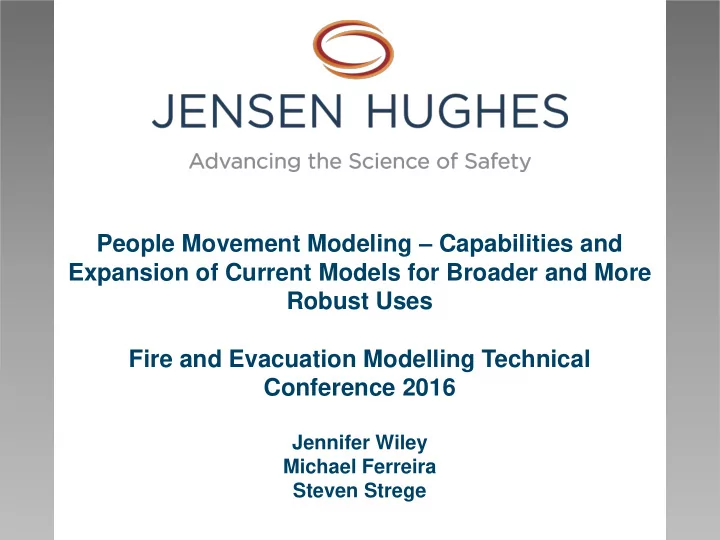

People Movement Modeling – Capabilities and Expansion of Current Models for Broader and More Robust Uses Fire and Evacuation Modelling Technical Conference 2016 Jennifer Wiley Michael Ferreira Steven Strege
Agenda Background Current Capabilities Non-Traditional Uses www.jensenhughes.com Advancing the Science of Safety 2
Background People movement models traditionally developed for evacuation in emergencies, especially fire Needs and interest in non-traditional applications have grown with the models Expansion of uses increases functionality for existing building models www.jensenhughes.com Advancing the Science of Safety 3
Current Capabilities Typical evacuation analysis: Build geometry Populate model Occupants proceed to exit (sometimes with intermediate tasks) www.jensenhughes.com Advancing the Science of Safety 4
Current Capabilities In general, primary goal is to exit Typically, some level of omniscience is inherent Routes Relative travel distance Locked/unlocked status of doors www.jensenhughes.com Advancing the Science of Safety 5
Ingress and Security Ingress into buildings or facilities with entrance procedures (security, ticketing) may incur significant delays www.jensenhughes.com Advancing the Science of Safety 6
Ingress and Security People movement models can be used to: Determine maximum arrival rate without congestion Identify limiting factors (e.g., screening equipment, elevators) Assess alternate approaches, arrangements, or equipment www.jensenhughes.com Advancing the Science of Safety 7
Ingress and Security Ingress into high- Elevators rise building Turnstiles Street Entrance Lobby Elevators Badge Scan/ Turnstiles Elevators Street Entrance www.jensenhughes.com Advancing the Science of Safety 8
Ingress and Security Queuing at Elevators Accumulated usage www.jensenhughes.com Advancing the Science of Safety 9
Ingress and Security Alternate turnstile placement Alternate Original www.jensenhughes.com Advancing the Science of Safety 10
Ingress and Security Detailed study of ingress w/badge scan and revolving door Field observations and modeling Lessons learned: Card misread and door “kickback” led to slower flow rates than manufacturer data Bursts and lulls in arrivals important to capture. Using averages may not be a good representation. www.jensenhughes.com Advancing the Science of Safety 11
Ingress and Security Existing models generally well-suited to ingress May require some “outside the box” thinking Potential adaptations (existing in some models) Turnstiles/ticket gates (fixed delay) Source term for occupants Final target/goal that is not an exit www.jensenhughes.com Advancing the Science of Safety 12
Dynamic Signage Exit signs are so ubiquitous as to become easily overlooked “visual clutter” in emergencies In response, new exit signs have been developed that Attract attention in emergencies Provide dynamic information www.jensenhughes.com Advancing the Science of Safety 13
Dynamic Signage Provides customized occupant egress routing and way-finding during an emergency exit Adjusts the egress path of occupants to mitigate exposure to hazardous areas Galea, et al., 2015 www.jensenhughes.com Advancing the Science of Safety 14
Dynamic Signage People movement models used for development and use of adaptive dynamic signage systems For intelligent systems: provide faster- than-real-time analysis for feedback to signs For manually-controlled systems: run many scenarios for guidance in anticipated events www.jensenhughes.com Advancing the Science of Safety 15
Dynamic Signage Models used for intelligent adaptive signage systems must be able to: Receive/use information on the active scenario (environmental sensors, etc) Run faster than real time Output results in a way that can be interpreted and implemented www.jensenhughes.com Advancing the Science of Safety 16
Active Wayfinding Existing models give occupants some level of omniscience with respect to Egress routes Travel distances Exit availability May lead to a more idealized or optimistic result No backtracking Reduced counterflow www.jensenhughes.com Advancing the Science of Safety 17
Active Wayfinding Redirection and signage limited in existing models Tends to require manual redirection Full implementation requires dynamic redirection or re-tasking Receive information within the model from Signage Direct observation Other occupants www.jensenhughes.com Advancing the Science of Safety 18
Assisted Evacuation and Carrying Behavior Traditional uses of models consider: Individual or group (some models) movement towards exit Mobility impaired move more slowly and may not use stairs Mobility aides (e.g., wheelchairs, walkers) increase size of occupants or not accounted for www.jensenhughes.com Advancing the Science of Safety 19
Assisted Evacuation and Carrying Behavior In practice, assisted evacuation results in: Complex staff itineraries Varying speeds Increased counterflow Altered movement patterns due to use of mobility aides Horizontal exiting or internal relocation www.jensenhughes.com Advancing the Science of Safety 20
Assisted Evacuation and Carrying Behavior When pushing a bed/wheelchair or carrying large items, different shape/size profile affects: Movement pattern Queuing and door throughput Recent airport study: Occupants w/roller bags reduced flow rate through doors by 33%. www.jensenhughes.com Advancing the Science of Safety 21
Assisted Evacuation and Carrying Behavior Some existing models have a group feature that could be adapted May not be practical for multiple trips for a single staff member In the case of internal relocation, a final goal that is not an exit may be needed May be possible to force this behavior indirectly with existing models www.jensenhughes.com Advancing the Science of Safety 22
Assisted Evacuation and Carrying Behavior New assisted evacuation function currently under development for Pathfinder Thunderhead Engineering, 2016 www.jensenhughes.com Advancing the Science of Safety 23
DISCUSSION Jennifer Wiley jwiley@jensenhughes.com www.jensenhughes.com www.jensenhughes.com Advancing the Science of Safety 24
Recommend
More recommend